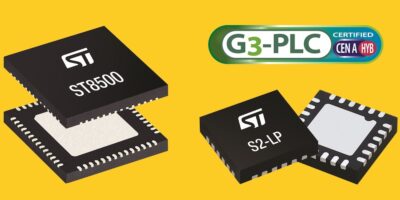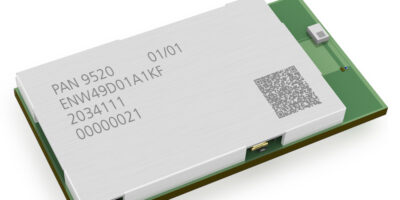The G3-PLC Hybrid specification is intended for seamless connectivity over powerline and wireless media. STMicroelectronics claims that its ST8500 and S2-LP chipset is the first to be certified according to the G3-PLC Hybrid communication standard.
The G3-PLC Hybrid specification allows smart-grid, smart-city, industrial, and IoT equipment to select the best available wireless or powerline channel at any time, automatically and dynamically, according to network conditions. As well as ensuring superior coverage, reliability, and scalability, it also allows cost-efficient system operation and enables new use cases, explains ST.
The hybrid chipset was introduced in 2020 and has completed the latest G3-PLC certification scheme, published in March 2021, which incorporates the Hybrid profile tests.
The certified chipset combines the ST8500 programmable multi-protocol powerline communication system on chip (SoC) and STLD1 line driver with ST’s S2-LP low-power sub-GHz radio transceiver.
Based on 6LowPAN and IPv6 and combining RF connectivity with the native G3-PLC protocol stack, the ST8500 SoC consumes less than 100mW in receive mode, in line with specifications to minimise the grid load imposed by new smart meters. It contains a high-performance DSP for real-time protocol processing and an Arm Cortex-M4F core for upper-layer processing and system management. Both the DSP and Arm core have their own code and data SRAM on-chip. Peripherals include an integrated 128/256-bit AES cryptographic engine. The analogue front end (AFE) for connecting to the STLD1 line driver is also integrated. The STLD1 communicates reliably, even across noisy power cables and with low impedance, with high drive capability and high linearity, says ST.
The S2-LP is a low power RF transceiver, intended for RF wireless applications in the sub-1GHz band. It is designed to operate in both the license-free ISM and SRD frequency bands at 433, 512, 868, and 920MHz, and can be programmed to operate at additional frequencies in the 413 to 479MHz, 452 to 27MHz, 826 to 958MHz, and 904 to1055MHz bands. The transceiver allows an RF-link budget greater than 140dB for long communication ranges and meets radio equipment regulations in territories worldwide including Europe, North America, China, and Japan. ST provides companion integrated balun/filter chips for the S2-LP that simplify antenna-connection circuitry and save PCB area in space-constrained applications.
The SoC’s programmability enables a software-defined implementation capable of supporting a broad portfolio of powerline protocol stacks, in worldwide frequency bands such as CENELEC and FCC, ST adds.
The ST8500 powerline communication SoC platform is used in smart metering, smart industrial and infrastructure applications. In addition to the chipset’s use in the smart grid market, ST’s hardware and firmware solution has been selected to power the official G3-PLC Alliance RF certification testing equipment.
The ST8500 SoC is packaged as a 7.0 x 7.0 x 1.0mm QFN56. The STLD1 and S2-LP are each packaged as 4.0 x 4.0 x 1.0mm QFN24. All devices are in full production.







